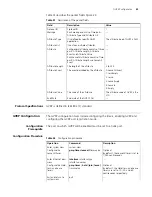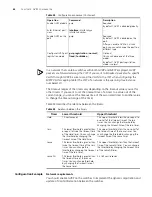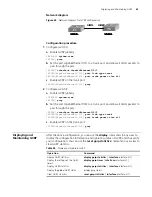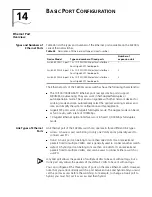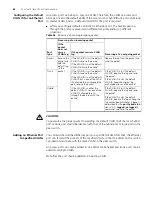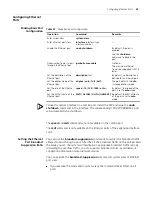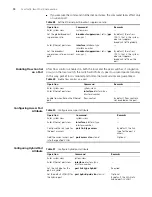
Overview
77
Static LACP Aggregation
Group
Introduction to static LACP aggregation
A static LACP aggregation group is also manually created. All its member ports are
manually added and can be manually removed (it inhibits the system from
automatically adding/removing ports to/from it). Each static aggregation group must
contain at least one port. When a static aggregation group contains only one port,
you cannot remove the port unless you remove the whole aggregation group.
LACP is enabled on the member ports of static aggregation groups, and disabling
LACP on such a port will not take effect. When you remove a static aggregation
group, the system will remain the member ports of the group in LACP-enabled state
and re-aggregate the ports to form one or more dynamic LACP aggregation groups.
Port status of static aggregation group
A port in a static aggregation group can be in one of the two states: selected or
unselected. In a static aggregation group, both the selected and the unselected ports
can transceive LACP protocol packets; the selected ports can transceive user service
packets, but the unselected ports cannot.
In an aggregation group, the selected port with the minimum port number serves as
the master port of the group, and other selected ports serve as member ports of the
group.
In a static aggregation group, the system sets the ports to selected or unselected state
by the following rules:
■
The system sets the "most preferred" ports (that is, the ports take most
precedence over other ports) to selected state, and others to unselected state. Port
precedence descends in the following order: full duplex/high speed, full
duplex/low speed, half duplex/high speed, half duplex/low speed.
■
The system sets the following ports to unselected state: ports that are not connect
to the same peer device as that of the master port, and ports that are connected
to the same peer device as that of the master port but their peer ports are in
aggregation groups different from the group of the peer port of the master port.
■
The system sets the ports unable to aggregate with the master port (due to some
hardware limit, for example, cross-board aggregation unavailability) to unselected
state.
■
The system sets the ports with basic port configuration different from that of the
master port to unselected state.
There is a limit on the number of selected ports in an aggregation group. Therefore, if
the number of the member ports that can be set as selected ports in an aggregation
group exceeds the maximum number supported by the device, the system will choose
the ports with lower port numbers as the selected ports, and set others as unselected
ports.
Dynamic LACP
Aggregation Group
Introduction to dynamic LACP aggregation group
A dynamic LACP aggregation group is automatically created by the system; it can be
removed only by the system. Users cannot add/remove ports to/from it. A port can
participate in dynamic link aggregation only when it is LACP-enabled. Ports can be
aggregated into a dynamic aggregation group only when they are connected to the
same peer device and have the same basic configuration (such as rate and duplex
mode).
Содержание 4200G 12-Port
Страница 10: ...8 CONTENTS...
Страница 14: ...4 ABOUT THIS GUIDE...
Страница 46: ...32 CHAPTER 5 LOGGING IN THROUGH WEB BASED NETWORK MANAGEMENT SYSTEM...
Страница 48: ...34 CHAPTER 6 LOGGING IN THROUGH NMS...
Страница 60: ...46 CHAPTER 9 VLAN CONFIGURATION...
Страница 64: ...50 CHAPTER 10 MANAGEMENT VLAN CONFIGURATION...
Страница 80: ...66 CHAPTER 13 GVRP CONFIGURATION...
Страница 98: ...84 CHAPTER 15 LINK AGGREGATION CONFIGURATION...
Страница 112: ...98 CHAPTER 18 MAC ADDRESS TABLE MANAGEMENT...
Страница 126: ...112 CHAPTER 19 LOGGING IN THROUGH TELNET...
Страница 162: ...148 CHAPTER 20 MSTP CONFIGURATION...
Страница 274: ...260 CHAPTER 29 IGMP SNOOPING CONFIGURATION...
Страница 276: ...262 CHAPTER 30 ROUTING PORT JOIN TO MULTICAST GROUP CONFIGURATION...
Страница 298: ...284 CHAPTER 33 SNMP CONFIGURATION...
Страница 304: ...290 CHAPTER 34 RMON CONFIGURATION...
Страница 338: ...324 CHAPTER 36 SSH TERMINAL SERVICES...
Страница 356: ...342 CHAPTER 38 FTP AND TFTP CONFIGURATION...
Страница 365: ...Information Center Configuration Example 351 S4200G terminal logging...
Страница 366: ...352 CHAPTER 39 INFORMATION CENTER...
Страница 378: ...364 CHAPTER 40 BOOTROM AND HOST SOFTWARE LOADING...
Страница 384: ...370 CHAPTER 41 Basic System Configuration and Debugging...
Страница 388: ...374 CHAPTER 43 NETWORK CONNECTIVITY TEST...
Страница 406: ...392 CHAPTER 45 CONFIGURATION OF NEWLY ADDED CLUSTER FUNCTIONS...
Страница 422: ...408 CHAPTER 48 UDP HELPER CONFIGURATION...

